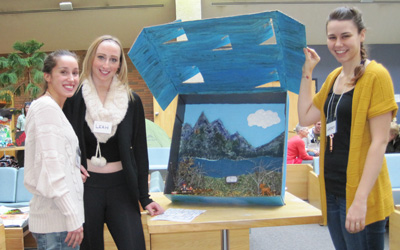
Recreation and Leisure students Lisa Fraser, Leah Scorah and Whitney Soloview with their exhibit at the recent RLS 331 "Exploring Leisure Education Through Art Exhibit" showing that outdoor recreation has to be seen holististically to appreciate the whole picture.
Leisure mapping project helps recreation students understand their own leisure experience; creates educative pathways to broaden others' leisure experiences in settings such as health, tourism, and outdoor recreation.
What happens when you take a group of recreation students - all non-artists - and ask them to map their personal leisure by creating art? Well, a lot of discomfort for a start, then, as you'd expect, a period of uneasy settling in, then transcending boundaries of what they thought they were capable of and an ultimate soaring in an explosive riot of colourful and meaningful ideas that truly bring out the inner Matisse. Even in the avowedly non-arty.
It's exactly what leisure professor Karen Fox was hoping for as part of the RLS 331 Leisure Education class. "The theme of the class was 'mapping leisure' and it was about mapping our own leisure to understand how we got to where we are - our identity and lifestyle around leisure," she says. "Then we looked at collaborative processes around how we could wonder with somebody else about how they came to whatever leisure they are doing and would like to do or might need to do - for health reasons, for instance. But all of it was grounded in the passion and excitement about the leisure and the purpose. We wanted to look at leisure in terms of how we might educate people in the community about the role of leisure in larger settings."
As for the interactive exhibits, the outdoorsy looking crew with an exhibit called "Boots Grow Roots" reflects a joyful hodge-podge of the camping and outdoor experiences of Colin Walbauer, Brent Krawchuk, Dani Burstrom and Kelci Mohr. "We just layered things on top of each other (signifying how our experiences build on each other)", says Walbauer, explaining the camping gear, photos, maps boots and other paraphernalia in their exhibit. "This (exhibit) is a collective memory of many different things. So we're reflecting on outdoor recreation and how we can engage people through telling our stories and memories."
At the 'IExplore (and there's a trip for that!!!)' exhibit, Kim MacMillan says all the team members are avid travelers and interested in tourism. "We are interested in tourism and how travelling can bring you new perspectives about people and the world," she says. So, by spinning a wheel that points to one of three colours, visitors are drawn out about how they relate to a colour in terms of a number of leisure environments depicted on the tourism-themed exhibit panels. "We also asked ourselves what drew us to the pictures of tourism we selected," says MacMillan.
Over at the 'Embracing Change" exhibit visitors are lavishly decorating cupcakes. Ashley Goodridge, Josée Meston, Zoe Wincure and Randi Schmidt are interested in recreation therapy and their exhibit reflects their chosen field of interest, showing the many forms of leisure that do not involve sport or physical activity. "We wanted to draw attention to the fact that our clients or patients are undergoing or experiencing some kind of change or are in a new environment," explains Meston. "We want to embrace that and make that a positive thing, as well as explore different types of leisure and how people can find different avenues of leisure that aren't about physical activity or sport, but include music and dance, for example."
And the cupcakes? "Recreation therapy is a creative experience," explains Goodridge. "If you'd experienced stroke, for example, the act of spreading icing on a cupcake would be a huge accomplishment." Turning to their colourful exhibit, she says, "Our poster also reflects how recreation therapists work. This came together step by step and that's what a recreation therapist does. Like the cupcake decoration activity, the outcome for each person receiving therapy is different, but it's their unique creation and outcome."
At an exhibit called 'Linking Community through Art' Alison Dawyd says her team wanted to create a space where art could be experienced as leisure. Around her people are getting into it: choosing props, making clay animals, or taking photos and making their own decorative frames to display them in. The exhibit mirrors Fox's own hopes for what students would learn, explains Dawyd. "Karen (Fox) created a space where people could do art and learn about their own leisure through art. She didn't have any set goals so the pressure of creating something amazing wasn't there: the art could be whatever you imagined it to be. We learnt a lot about our own leisure through that - what we used to do as kids and how that has transferred into what we do now."
For Fox the ingenuity and artistry, and the profound thought conveyed in the student exhibits and journals underscore a lesson well learned on the importance of leisure in our lives. "I have always argued that leisure is part of our daily rhythm and that is, in fact, what the students' journals show. Their learning about leisure began with how they played with their grandparents, their experiences with food, or played board games, for example.
"Leisure is the rhythm of how we stay connected with people; it's the time in our life when we're not as bound in obligations as we are at work, or school, so we have a chance to be expressive and creative around who we are and to explore new boundaries."